 Sweet pepper belongs to the category of nightshade crops, in the development of which the most attention should be paid to the root system of plants. We are talking about timely soil fertilization, maintaining moderate soil moisture, as well as creating optimal climate conditions: without sudden changes in air temperature.
Sweet pepper belongs to the category of nightshade crops, in the development of which the most attention should be paid to the root system of plants. We are talking about timely soil fertilization, maintaining moderate soil moisture, as well as creating optimal climate conditions: without sudden changes in air temperature.
A variety of peppers is unpretentious in care if it is pain resistant, for example, to the manifestation of late blight or fungal infections, and also has the ability to form the ovaries of future fruits even in adverse weather conditions.
Harvested Sweet Pepper Varieties
The choice in favor of stable and unpretentious varieties of sweet pepper is due to the need to grow it in open ground, as well as in the greenhouses of the regions of the middle and northern stripes with a predominantly cold climate. At the same time, the plants retain a high yield of fruits with a characteristic balanced taste.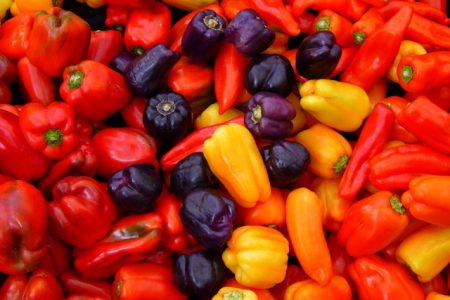
Hercules
Hercules sweet pepper belongs to the category of varieties that are most adapted to the unpredictability of the local climate. Bushes are compact and semi-spreading. The height of the plants is about 50 cm. The ripening period lasts about 100 days from the moment of seedling emergence. Ripe fruits are rich in red and weigh about 200 grams.
You can use pepper in a period of both biological and technical maturity. In the second case, the fruits have a dark green color, but are devoid of any bitterness in taste. The height of the fruit is 12 cm, and the wall thickness with juicy fragrant pulp is about 7 mm. Hercules pepper is perfect for fresh use, for use in the preparation of hot dishes, as well as preservation for the winter.
An important point also relates to productivity: from one bush you can get about 3 kg of fruits. At the same time, you can harvest from July to October. The demand for the variety among experienced gardeners is also due to resistance to most dangerous diseases. Plants differ in their special immunity with respect to fusarium, which is manifested by the rapid decay of the root system and neck.
Of the mandatory care requirements, it is worth highlighting:
- timely moderate watering (at least 2 times a week);
- top dressing (no more than twice during the month and with a minimum break of 7 to 8 days);
- loosening the soil so that a crust does not form, and the roots can receive the necessary oxygen.
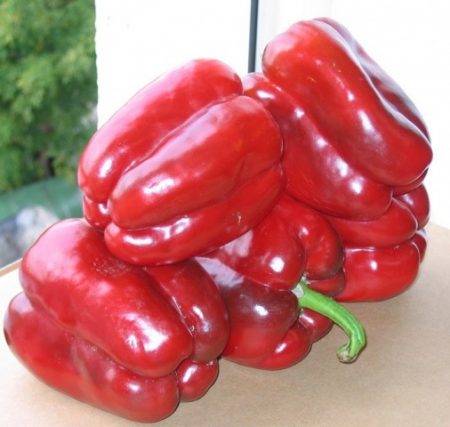
An important advantage of the Hercules variety is its good keeping quality while preserving all its beneficial properties and qualities, which is necessary for cultivation for the purpose of further sale.
Siberian bonus
Observance of the minimum conditions for growing sweet pepper. The Siberian bonus makes it possible to obtain about 15 large fruits of orange color. The weight of each of them is about 280 - 310 grams. The height of the bushes, as a rule, reaches 80 cm. The variety is suitable for cultivation in open ground conditions, as well as in protected greenhouses.
The variety is used primarily in fresh form. The maximum yield can be obtained if grown in seedlings.Sowing seeds is reproduced 60 - 70 days before the planned planting in a permanent place. If an air temperature of at least 24 - 26 degrees Celsius is required for seed growth, then the permanent soil must warm up to at least 16 - 17 degrees above zero.
When planting, it is necessary to observe the density of plantings - not more than 6 - 7 bushes per 1 sq.m. As the lower leaves grow, it is necessary to break off so that the tops do not touch the ground. The variety is resistant to late blight, manifested by gray-brown spots with white mold on the edges of the stems of pepper and its leaves.
Of the mandatory care requirements, it is worth highlighting timely watering, fertilizing the root system with minerals (1–2 times a month) and timely loosening of the soil after rains (to prevent crust formation).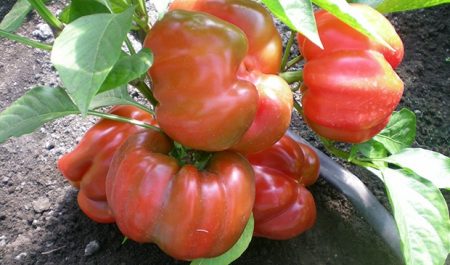
Sun of italy
Unpretentious variety of sweet pepper in care The sun of Italy is distinguished by large bright yellow fruits weighing up to 490 - 510 grams. The second important point concerns the fleshy pulp and thick walls - about 6 - 8 mm. At the same time, pepper has a balanced taste without bitterness. If only the mandatory requirements for watering and timely top dressing are met, you can count on getting 6 - 8 kg of the crop.
From the appearance of the first seedlings to the harvest of the first crop, about 115 to 120 days pass. Peppers are used. The sun of Italy, both in fresh form, and for the preparation of sauces and even winter preservation. Since plants can easily tolerate the unpredictability of climatic conditions, they can be grown not only in greenhouses, but also in open ground (provided that the seedling method is used).
The bushes show resistance to such fungal and viral lesions as late blight, fusarium and the black leg. Easy enough, the pepper variety The sun of Italy tolerates short-term cooling, without losing the ability to form the ovaries of future fruits.
Of the necessary growing conditions, it is necessary to highlight timely mulching, which protects the root system from excessive moisture loss by evaporation, as well as loosening the soil to supply the roots with oxygen. Watering should be carried out at least 2 times a week using warm water (at least 25 - 28 degrees). The period between fertilizers takes at least 7 - 10 days. Mandatory is feeding during the planting of bushes in a constant place and before they begin to bloom.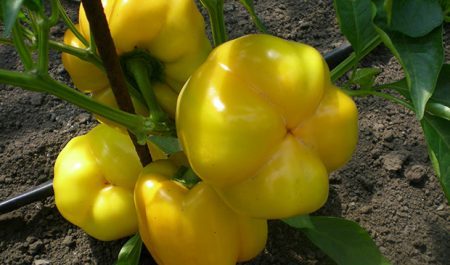
Shorokshary
The Shorokshara pepper variety is high-yielding, as it is ready to provide about 3 - 3.5 kg of the crop from one bush, subject to the minimum requirements for care. The fruits themselves are orange-red, oval-cuboid in shape and wall thickness up to 6 - 8 mm. At the same time, the variety has a balanced sweet taste and is successfully used both for preparing fresh dishes and for canning.
The main feature of growing Shorokshary varieties concerns the resistance of the plant to damage of apical rot, which is manifested by brown fruits on the walls of the fruits and most often indicates a lack of calcium (the substance tends to break down when the soil changes sharply: from too wet to too dry).
The growing season takes about 110 - 125 days. The bushes are characterized by a standard shape and reach a height of about 50 - 65 cm. The weight of one fruit is 100 - 150 g.
The process of successfully growing Shorokshara varieties has several proven secrets regarding top dressing. For these purposes are well suited:
A prerequisite is also sufficient coverage of the site and the absence of serious frost.Outdoor cultivation is allowed in the regions of the southern and middle strip. With possible frosts in the second half of May, it is recommended to conduct greenhouse plant cultivation.
Belozerka
Belozerka peppers belong to the category of medium early plants, since the ripening period is only 115 days from the appearance of the first seedlings. Ripening of fruits begins with a green color, which gradually turns into a light yellow color. With biological maturation, pepper acquires a saturated red color. Maturation occurs almost simultaneously.
The average height of the bushes is 40 - 70 cm. The fruits themselves gradually become cone-shaped and can weigh about 80 - 90 grams each. The wall thickness is 6 - 7 mm, which is quite enough for a good long shelf life of the harvested crop and its transportability for sale. Pepper itself is actively used fresh, as well as for winter preservation and even freezing.
Unpretentiousness to cultivation consists only in sufficient sunlight and compliance with moderate soil moisture. The bushes retain the ability to form ovaries under adverse conditions, and also show resistance to lesions by alternariosis and verticillosis (fungal diseases manifested by brown spotting on leaves and fruits), as well as viral diseases.
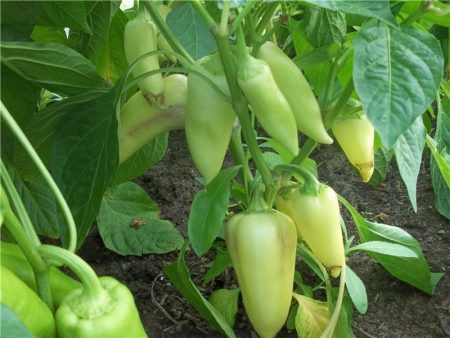
Of the prerequisites for growing a good crop, you should highlight regular watering with warm (required) root water. To increase the varietal resistance of the variety, it is recommended to soak the seeds before sowing in a light pink solution of potassium permanganate (for 20 to 30 minutes). A pick can be carried out only after at least two full leaflets are formed on the stems. In addition to loosening and top dressing with mineral complexes, attention should be paid to regular weeding of the site from weeds and hilling of bushes, which preserves more moisture inside the soil.
Anastasia
The demand for Anastasia pepper varieties among experienced gardeners is due not only to high productivity and unpretentiousness in care, but also to sweet crispy pulp with a fruity flavor. Subject to regular moderate watering and loosening of the soil, you can expect to receive about 6 - 7 kg of fruit per 1 sq.m. or 8 to 12 fruits from one bush.
At the same time, the bushes themselves are quite compact and grow only up to 60 - 80 cm. This makes it possible to use the plot more economically in an open garden, as well as in greenhouses and greenhouses. The fruits themselves have a juicy flesh, a characteristic cherry color and are actively used both in fresh salads and in baked grilled dishes.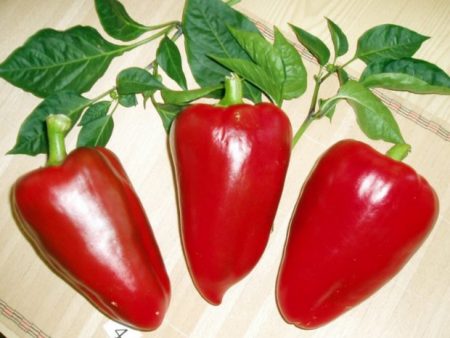
By size Anastasia pepper is 15 cm long and about 200 - 230 grams by weight. Unpretentious care consists in the plant's immunity against many common diseases, for example, fusarium and apical rot, as well as the ability to form ovaries even in conditions of prolonged drought. The same applies to low air temperature and insufficient lighting of the site. The growing season lasts about 120 - 130 days. For top dressing, pollination with sifted wood ash can be used. In case of increased risk of night frosts, it is recommended to cover plants with special film tunnels. For mulching suitable rotted straw or pine needles, which can always be found in the household or in the nearest forest.
Golden anniversary
The peculiarity of the Golden Anniversary pepper variety is the ability to get golden yellow fruits with a fragrant sweet taste without much effort and skill. The growing season lasts about 115 - 120 days. Moreover, the fruits have a flat-round shape and weigh about 110 - 180 grams.The bushes themselves are quite compact, not higher than 30 cm, which allows them to grow not only in the garden or in the greenhouse, but also on the windowsill of the sunny side of the balcony.
The juicy and crisp flesh has a rich taste. Wall thickness can reach 9 - 10 mm. Golden Anniversary pepper is suitable for fresh consumption, as an ingredient in sauces and salads, as well as for preservation for the winter. With minimal compliance, you can expect to receive 3.5 - 4 kg of a golden aromatic crop with 1 sq.m. plantings.
The unpretentiousness of the Golden Jubilee variety is due to the increased resistance to damage by verticillosis, which manifests itself as brown spots on the fruits and leaves. Not afraid of the variety and spring frosts. You can plant seeds directly in the ground under a protective film shelter, but a separate cultivation of seedlings in a warm, lit place (at least 17 - 18 degrees Celsius) will give stronger sprouts, which means a good harvest.
You can transplant plants over the age of 1 - 1.5 months. Of the mandatory conditions of care, it is worth highlighting:
- timely weeding of the plot from weeds;
- regular moderate watering (at least once a week), preventing stagnation of water in the soil (which prevents the root system from being supplied with oxygen);
- soil fertilizing at the stages of sowing seeds, replanting plants and the beginning of flowering of the bushes themselves (but not more often than once every 3-4 weeks).
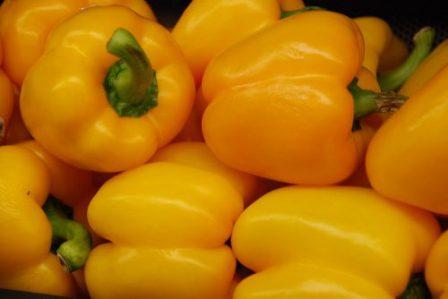
In order to protect against harmful insects, it is recommended to spray the bushes, which is carried out 1 time in 25 - 35 days. For this, chemicals or home remedies can be used. If fungicides are used in the work, then you should take care of your own safety in advance, and also carry out the work no later than two to three weeks before the planned harvest of the first crops. Of the proven home remedies, a two-day infusion of celandine is suitable (1 - 1.5 kg of chopped fresh grass per 10 liters of water). The procedure must be repeated after 8 to 12 days.
Bel Goy
Pepper Bel Goy belongs to the category of large-fruited and late-ripening plants. The height of the bushes reaches 1.2 - 1.5 cm. At the same time, pepper can be grown both in the greenhouse and on open ground. The demand for the variety among experienced gardeners is the ability to get large fruits weighing about 400 - 600 grams. At the same time, the plant itself does not require special skills in the process of care.
If the cultivation of Bel Goy pepper is carried out on healthy soils and in a protected room, then no protective manipulations are necessary. Due to the large parameters of the fruit from one bush, you can collect about 2.5 -4 kg of crop. Of the mandatory requirements, it is necessary to highlight the acquisition of high-quality varietal seeds, the use of fertilized non-acidic loose soil and timely watering of plants.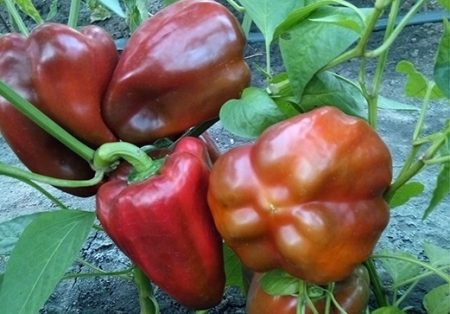
Soil cultivation is carried out so that a crust does not form and the root system can receive the necessary oxygen. Fertilizing the soil is carried out at least 3-4 times with a break of about 4-5 weeks. Minor cooling of the Bel Goy variety is also not terrible.
Red Square
The lack of special requirements for the care and cultivation is different for the Red Square pepper variety. Plants are quite resistant to long rains and cold snap. At the same time, the ability to form the ovaries is preserved and, after 95 to 110 days after germination, give the first crop. The shape of the fruit is cuboid, and the average weight is about 220 - 300 grams. The wall thickness is 8 - 10 mm, which ensures the crispness of the pulp, as well as the possibility of long-term transportation of the harvested crop.
An important advantage of the Red Square variety is disease resistance, especially in relation to fungal and viral infections.First of all, this applies to fusarium, apical rot and verticillosis, which are manifested by rotting of the root system and neck, as well as the destruction of the integrity of fruits and leaves.
Bushes of pepper grow powerful and with a height of 60 - 70 cm. They are not afraid of a strong wind, but it is not recommended to choose places with strong cold drafts for cultivation. According to the method of use, the variety is versatile, since it is successfully used fresh, as well as for the preparation of sauces and preservation.
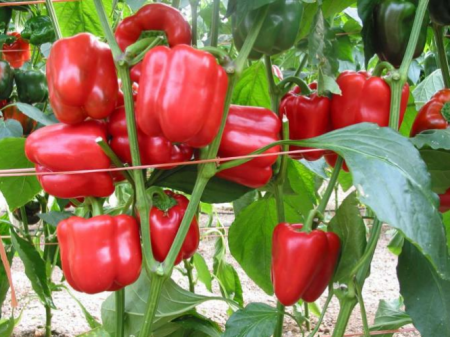
2 weeks before planting, the seedlings are necessarily hardened by removal to the open air (daily for several hours with a constant increase in the time spent in the sun and in the wind).
Ivanhoe
The fruits of the Ivanhoe variety are distinguished by a special sweetness and aroma, and the bushes need only reliable protection against possible frosts and timely watering of the root system. The growing season lasts about 110 - 115 days from the moment the first seedlings appear. Ripe fruits are light red and cone-shaped. The wall thickness reaches 6 - 7 mm.
High productivity allows counting on receiving 7 - 8 kg of fruits from 1 sq.m. At the same time, pepper needs to be grown in seedlings, sowing 60 to 65 days before the planned transplant to a permanent place. Of the advantages of the Ivanhoe variety, it is also worth highlighting earlier ripening, so that the plant is not afraid of late blight. To protect against fusarium and verticillosis, early seed treatment with a weak potassium permanganate solution can be carried out. Seeds are lowered into the solution for 25 to 30 minutes, and then dried.
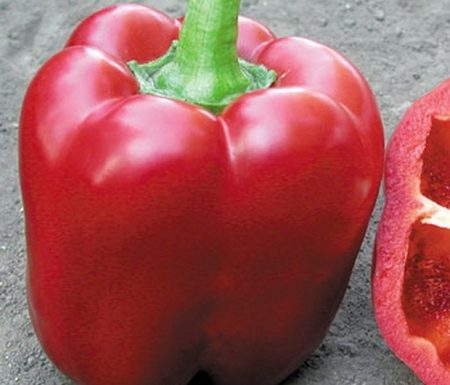
If pepper is grown on open ground, a special film shelter can protect it from cold snap. Watering plants should be carried out at least 1 to 2 times a week. Timely loosening of the soil and harvesting weeds will allow you to get bright red fruits with a weight of 95 - 140 grams, which are saturated with many useful vitamins and substances. Due to this, pepper is recommended subject to dietary nutrition, as well as an auxiliary substance in the prevention of cancer. Aivengo pepper is successfully used fresh, and also lends itself to heat treatment during canning.
Pound
Funtik pepper variety is characterized by increased productivity, because from one bush you can collect about 12 - 18 fruits with an average weight of 140 -180 grams each. The variety belongs to the category of early ripe, therefore, the first harvest can be expected in 120 - 130 days from the moment of the appearance of the first seedlings. The height of the bushes is about 55 - 70 cm. Ripe fruits differ in rich red color.
In this case, the plant does not need additional protection against damage by verticillosis and tobacco mosaic. For a good yield, moderate regular watering is enough (about 1 - 2 times a week) and 3-4 feeding for the whole season (the last should be carried out before the first flowers appear on the bushes). On 1 sq.m. You can plant no more than 4 - 5 bushes of pepper.
The unpretentiousness of the variety is determined by the ability to successfully grow peppers, both in heated greenhouses, or greenhouses, and on open ground.In the latter case, it is recommended to use a protective film and cover the site itself in case of the possible occurrence of night spring frosts.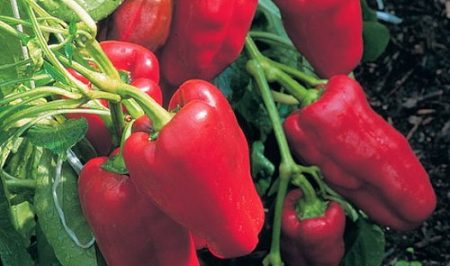
Czardas
The main feature of the Chardash pepper variety is its exquisite color: if at the very beginning of ripening the cone-shaped fruits have a bright lemon-yellow color, then by the end of the growing season they turn orange. In this case, you can use the fruits at any stage of ripening. After harvesting, peppers continue to maintain their appearance and taste for 1.5 to 2 months.
The average weight of the fetus is about 190 - 230 grams. The wall thickness is 5 - 6 mm, which preserves the characteristic crispness of the fruits and ensures ease of their long transportation. An important advantage is the compactness of low bushes (up to 55 - 60 cm), which allows more economical use of the site. A good harvest is the collection of about 12 - 15 kg of pepper with 1 sq.m. Moreover, up to 15-17 fruits can grow on one bush.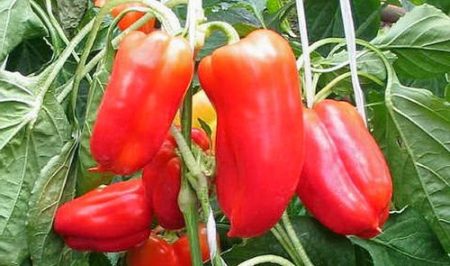
The variety belongs to the category of unpretentious plants, because observing elementary watering (at least 1–2 times a week), fertilizing with mineral complexes and loosening the soil is quite enough to obtain the desired crop. Variety Chardash patiently endures short drought and strong wind, and is also resistant to sudden unexpected cold snap, thanks to which it is successfully grown not only in greenhouses, but also on the street.
Cow ear
Variety of pepper Cowskin ear belongs to the category of mid-season varieties. The ripening period takes about 120 - 125 days. The bushes grow low, but sprawling, so the seedlings should be planted at a distance of at least 40 - 50 cm.The fruits resemble an elongated cone in shape (up to 12 - 16 cm), while the weight of the average fruit is about 180 - 210 grams.
During the period of technical maturity, the fruits are distinguished by a dark green color, and with the onset of biological, I get a saturated red color with a glossy shine. At the same time, the palatability of the fruits does not change, and the flesh does not bite even when unripe. Pepper Cow’s ear is used, both in fresh form and salads, and as an ingredient in homemade preparations.
Unpretentiousness in the care is due to the presence of persistent immunity against such viral diseases as tobacco mosaic and verticillosis, which are manifested by green and brown spots on the leaves and fruits. Variety Cowskin ear successfully retains the ability to form ovaries in adverse weather conditions.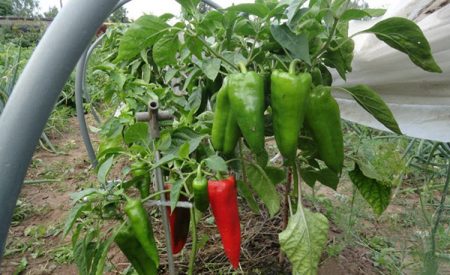
Among the mandatory requirements, it is worth highlighting the timely harvesting of weeds, loosening of the soil and irrigation with warm water (at least 1 time per week). While the bush is growing stronger and developing, irrigation must be carried out from above, onto the leaves, but with the appearance of the first flowers and ovaries, water should be supplied to the root of the plant. That is how you can count on getting 2 - 3.5 kg of fruit from one bush.
Atlant
The demand for Atlant varieties is due to the increased content of vitamin C, as well as the ability to grow the first crop by the end of June. The fruits are juicy, sweet taste and fleshy crisp pulp. In this case, the weight of the fetus can be about 110 - 170 grams. The biological maturity of pepper occurs after 130 - 140 days from the moment of the appearance of the first seedlings, and technical maturation occurs already on 110 - 115 days. The variety is distinguished by good productivity, if after cultivation it is possible to collect about 3-5 kg from 1 sq.m.
An important uniqueness of the variety lies in the ability to harvest twice, but for this it is necessary to hurry a little with growing seedlings in the spring. At the same time, the second time the harvest is as generous as the first.
As for resistance to pests and diseases, the variety is distinguished by immunity against Fusarium and Verticillosis, and is not afraid of vertex rot. The only protection in the form of spraying bushes concerns the control of harmful insects that want to feast on the leaves of the plant. In such cases, special preparations of fungicides or a two-day garlic infusion can be used, for which 250 grams of crushed garlic per 10 liters of water is needed. It is important to note that treatment with chemicals should be carried out no later than 2 to 3 weeks before the planned harvest.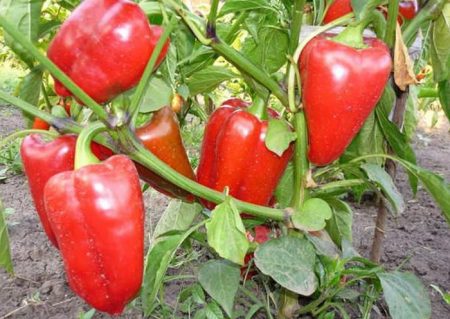
Among the recommendations for care, it should be noted that the Atlant variety tolerates drought much easier than a lack of daylight or unexpected frosts. For watering, exclusively warm water should be used (about 28 - 30 degrees). Subsequent irrigation is carried out only after the soil begins to dry out. Mandatory top dressing consists of only two stages: during the transplant of pepper and before setting the first buds. In the first case, nitrogen mixtures are relevant, which can be prepared at home by combining manure with clean warm water in a ratio of 1 to 12. For the second stage, potassium-phosphorus complexes are more suitable.
The only important requirement concerns the timely and careful garter of the bushes to the additional support. Thin narrow boards are best suited for this.
Eroshka
The variety of pepper Eroshka belongs to the category of mid-ripening and undersized plants. The growing season lasts about 100 - 105 days from the moment the first seedlings appear. The average height of the bushes is about 50-60 cm. Due to their compactness, it is possible to use a plot of soil more economically (8-10 bushes per 1 sq.m.). This is especially true of greenhouse cultivation methods.
Ripe fruits have a rich red color and weigh about 200 grams. The fleshy flesh and dense skin provide a characteristic crispness of the fruit, which makes it possible to use them not only in fresh form, but also as preservation for the winter.
The variety is pain resistant against viral lesions of tobacco and watermelon mosaics, fusarium, which is manifested by rotting of the root system of plants, as well as late blight and apical rot. At the same time, the bushes retain the ability to form ovaries even with a significant decrease in air temperature. Eroshka is one of the most adapted varieties for too changeable and unpredictable weather conditions.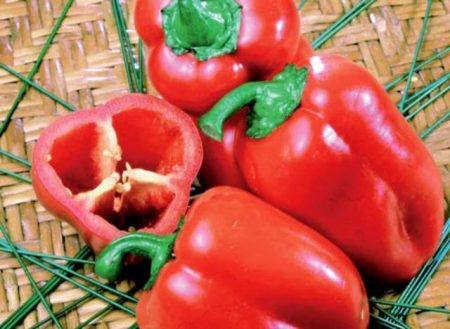
Good plant productivity makes it possible to obtain 10 - 16 fruits from one bush. At the same time, watering the site is carried out as necessary. A short drought is tolerated much easier than stagnation of excess water, due to which there is a lack of oxygen and the root system begins to rot.
Lemon Miracle
The ability to get a good harvest of sweet pepper with a bright yellow color, while observing only the minimum care requirements, also differs the Lemon Miracle variety. The plant belongs to the category of early ripening. It is recommended to grow seedlings, starting with sowing seeds 60 - 70 days before the planned planting in open ground. If the territory is characterized by frequent and unexpected frosts even in the second half of May, Lemon Miracle Pepper is best grown in a greenhouse.
The average weight of the fetus is about 110 - 130 grams. Moreover, from 1 sq.m. You can collect at least 4.5 - 5.5 kg of ripe and tasty harvest (no more than 3 - 4 bushes on the site). At the maturity stage, the peel becomes glossy, and the thickness of the fleshy walls reaches 6 - 7 mm. Peppers are used not only in fresh form or for cooking, but also as preserves for the winter.
The variety is quite resistant to the manifestation of fusarium and verticillosis.He is not afraid of the appearance of vertex rot and tobacco mosaic. Among the necessary cultivation conditions, it is worth highlighting the maintenance of the soil in a moderate state of humidity and the conduct of 3-4 feeding, with a break of 3-4 weeks. After the first flowers appear, watering should be directed to the root system of plants, and not to the leaves.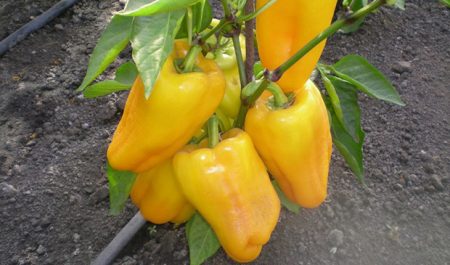
How to calculate an unpretentious variety
About how easy it is to care for a variety of pepper, you can find out already from the information provided on the package of seeds. First of all, this concerns a suitable range of air temperature and the duration of a warm summer, if pepper is grown on open ground. The second point concerns the ability of the bushes to retain the ability to form ovaries under adverse weather conditions, for example, with the onset of night frosts, prolonged drought or, conversely, prolonged heavy rains and wind.
No less important is information about the pain tolerance of plants (their resistance to viruses and diseases), as well as on the necessary care requirements, for example, tying up bushes with a trellis method or additional fertilizing of the soil at the stage of formation and development of the fruits themselves. Many of the unpretentious varieties of pepper tolerate drought more easily, but can die due to stagnation of water that does not allow oxygen to pass to the roots, due to which the process of root decay and the death of the whole bush can begin.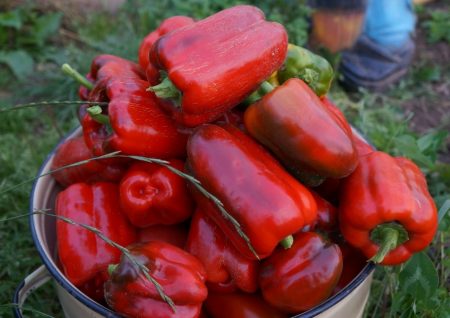
Reviews
Irina Andreevna, 59 years old
To minimize the risk of pepper damage by various diseases, it is recommended to pre-treat the seeds with a light pink solution of potassium permanganate. Soak is necessary for 30 to 40 minutes, and then gently dry. The second important point concerns the normalization of soil acidity: for this you can use sifted wood ash or lime (20 - 30 kg per 1 hundred parts of a site). Careful digging should be carried out during the autumn preparatory work. At the same time, rotted manure can be added to the soil.
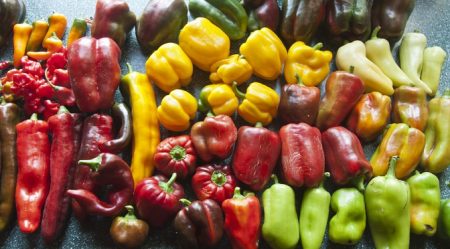
Fedor Stepanovich, 68 years old
If pepper is grown in a greenhouse, it is imperative to prevent damage to the bushes by the spider mite. It is characterized by prolonged drought in the room and too high air temperature without adequate ventilation. In such cases, it is necessary to resume the regime of watering the bushes, to establish full ventilation of the greenhouse, and to spray the bushes themselves with soda solution (200 grams per 8 - 9 liters of water). After 8 to 12 days, the procedure must be repeated. An alternative is a two-day infusion of celandine, for which it is necessary to take 1 - 1.5 kg of chopped fresh grass and 9 - 10 liters of water.
Veronika Alekseevna, 39 years old
In the cultivation of pepper, an important role is also played by the principle of crop rotation: it is not recommended to plant pepper where tomato was grown before. It is better to choose a place after legumes or potatoes. The first mandatory top dressing relates to the autumn preparation and fertilizing of the soil with its subsequent digging. And this applies to both open areas and greenhouse premises.

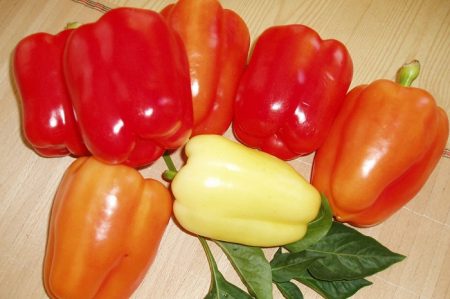



 Calorie pepper stuffed with meat and rice - BZHU per 100 grams
Calorie pepper stuffed with meat and rice - BZHU per 100 grams Gorky pepper - the best varieties for open ground
Gorky pepper - the best varieties for open ground Hot pepper seeds - the best varieties for open ground and reviews
Hot pepper seeds - the best varieties for open ground and reviews Capsicum tincture for hair - how to use and reviews
Capsicum tincture for hair - how to use and reviews